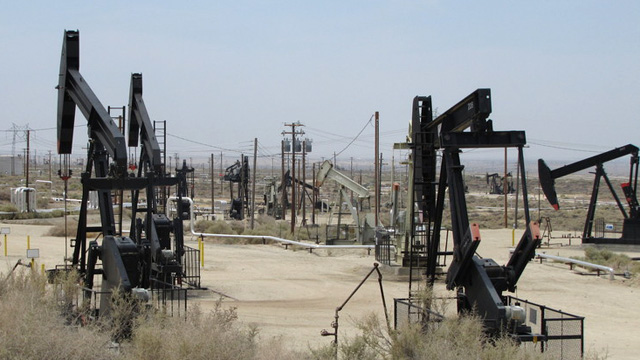Only about 20% of California’s oil is produced from fracked wells, according to the state. Still, opposition remains intense, with activists arguing that fracking endangers drinking water supplies, air quality and public health and imperils our oceans.
Dozens of California counties and cities seem to agree, having passed ordinances banning the procedure, even where there is no oil drilling. And fracking has become a proxy for environmentalists’ push to ramp down new oil production, which has been declining in California for the last four years.
Assemblyman Al Muratsuchi said he would support a fracking ban but preferred to come at the issue more broadly, with legislation to address “all oil and gas development that [threatens] the health of children and families or our national monuments and other protected lands.” A Democrat from Torrance, he wants to bar any new construction of oil infrastructure on state land.
In a separate proposal, he would require that other new oil development, which could include fracking, be sited at least a half-mile from child care facilities, hospitals and residences.
“I continue to believe … that the evidence is clear about the potential harmful impacts of fracking,” the legislator said.
Other pending bills would subject the oil industry to more regulation, including a severance tax.
To the oil and gas industry, fracking bans are a thinly veiled assault on fossil fuels that could cripple California’s economy, throw thousands out of work and drive up the cost of gas at the pump.
“It would be irresponsible to ban hydraulic fracturing and other safe well-stimulation techniques in California,” said Catherine Reheis-Boyd, president of the Western States Petroleum Association, an industry group. “Californians consume all of the oil we produce under the strictest environmental protections on the planet.”
Modern fracking has been practiced in oil fields since the 1940s, but it burst into the national spotlight in the last decade when companies began unlocking troves of natural gas in underground shale. The technique for restarting decades-old wells has brought new life to the aging oil fields around Bakersfield.
Fracking created a boom that made the United States the world’s biggest oil producer. The procedure is exempted from the federal Safe Drinking Water Act, which otherwise requires myriad testing and safety measures.
In some parts of the country, evidence has emerged that waste fluids from fracking have contaminated drinking water, and swarms of earthquakes from fracking and other high-pressure injections—frackquakes—have bedeviled Oklahoma.
But California’s unique geology—fracking occurs at shallower depths and probes a different type of strata—means the state has not experienced such problems on the same scale. And fracking in California requires much less water than in other states.
Gabe Garcia runs the Bakersfield office of the federal Bureau of Land Management and oversees the U.S. government’s oil holdings in California, leasing about 200,000 acres for energy development. The Trump administration rescinded Obama-era federal fracking regulations; Garcia said that operators on federal leases in California get permits from the state and abide by California’s rules.
Garcia said the persistent intense criticism of fracking is unfounded. “A lot of it comes from people who are not experts in the field,” Garcia said. “They make their determinations based on what’s going on elsewhere in the country.”
California’s relatively strict fracking regulations, set in 2013, call for more scientific study of fracking and related practices and more careful permitting of well operations, in addition to requiring disclosure of chemicals. Even with that reporting requirement, public health officials say they have difficulty gauging the potential impact of fracking’s chemical stews.
The most comprehensive analysis of fracking in the state was conducted by the California Council on Science and Technology in 2015, as part of an examination of well-stimulation techniques. One of the report’s conclusions was that scientists were unable to determine fracking’s full effects on human health, the environment or groundwater because they don’t fully understand all the chemicals used or how they interact with one another.
“Operators have unrestricted use of many hazardous … chemicals in hydraulic fracturing,” the report found. Some of the same chemicals are used in other oilfield procedures as well.
“In terms of understanding the hazards and risk to human health and the environment, we have not gotten much further in our understanding of chemicals used in oil and gas in California,” added Seth Shonkoff, a public health scientist and one of the report’s lead authors.
New state rules took effect this month governing a routine and, to some, more troubling category of operations that includes high-pressure injections of steam or acid to rework or stimulate oil production or during maintenance. Those practices, according to Shonkoff and others, use more dangerous chemicals than routine hydraulic fracking, are more polluting and merit more attention from groups focused on fracking.
Parties on all sides of the issue say they have had discussions with Newsom’s staff since he took office. Leaders of the anti-drilling Leave It In The Ground campaign, who dogged Brown, and other groups are arguing that a fracking ban should be part of California’s overall strategy to reduce carbon emissions and improve public health.
“There are big-picture things, like stop approving new fossil-fuel projects and phase out oil and gas production,” said Kassie Siegel, a senior attorney at the environmental group Center for Biological Diversity. She said weaning California off fossil fuels should include retraining and re-employment of oil workers.
The powerful State Building and Construction Trades Council also has weighed in, swarming legislators in the Capitol this week, airing their concerns about job loss if California’s lawmakers “over-regulate” the oil industry.
All sides are waiting for a clear message to emerge, but they won’t wait forever.

